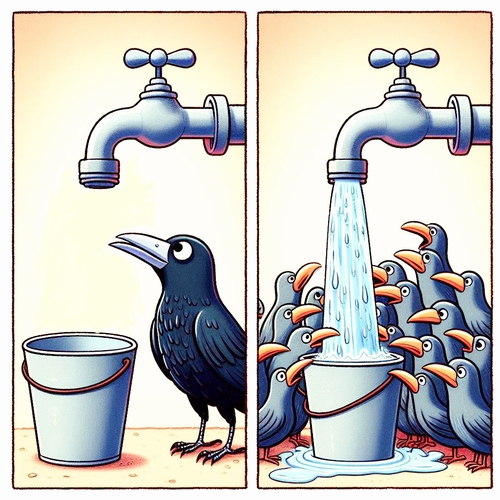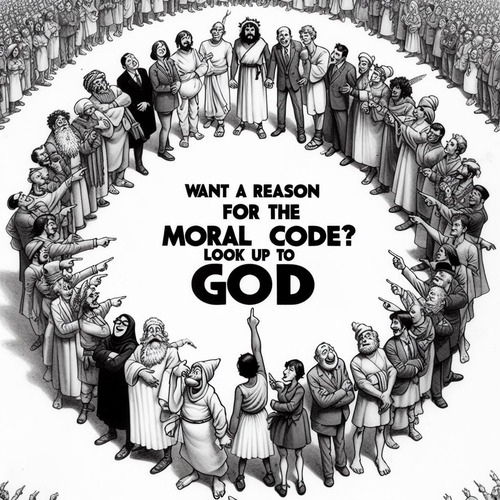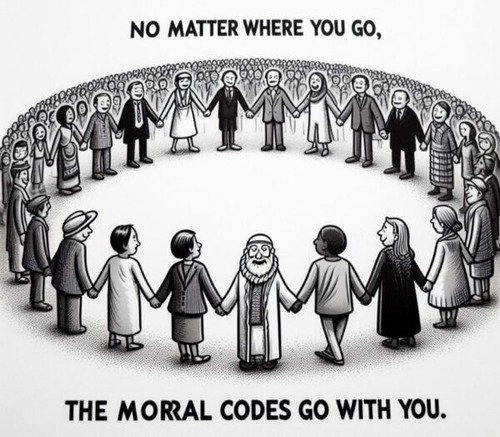The Origin of Sex: Can Science Explain It Without God?
When we hold a newborn baby, we’re witnessing one of nature’s most astonishing miracles. That tiny human began when two microscopic cells—one from mom, one from dad—somehow knew exactly how to find each other, merge their genetic information, and begin building a brand new person with a unique combination of traits from both parents.
But here’s what is surprising: many evolutionary biologists are astounded sexual reproduction exists at all. It’s so complex, so costly, and so seemingly impossible to evolve that one famous scientist called it “the queen of problems in evolutionary biology.”
Let’s explore why the origin of sex presents such a massive challenge to evolutionary theory—and why the evidence points increasingly toward intelligent design.
THE MAGNITUDE OF THE PROBLEM
Think about what sexual reproduction actually requires. Two separate types of organisms—male and female—must evolve simultaneously. Each must produce specialised cells (sperm and eggs) that are perfectly designed to unite. The male’s contribution must somehow find and penetrate the female’s contribution. Then these two cells must merge their genetic material in precisely the right way to create a viable offspring.
This isn’t like evolving a longer beak or different coloured fur. This is like two separate construction companies, working independently, somehow building perfect puzzle pieces that fit together flawlessly—without any communication or planning between them.
Even Charles Darwin struggled with this problem. In his private correspondence, he admitted thinking about the evolution of sex made him feel “quite sick.” More recently, evolutionary biologist Graham Bell wrote sex “is the queen of problems in evolutionary biology. Perhaps no other natural phenomenon has aroused so much interest; certainly none has sowed as much confusion.”
THE INTRICATE DESIGN THAT POINTS BEYOND CHANCE
To understand why sex poses such a challenge to evolutionary thinking, let’s examine the staggering complexity involved.
The Precision of Cell Division: Sexual reproduction requires meiosis—a sophisticated genetic shuffling system that carefully pairs chromosomes and splits them so each reproductive cell gets exactly half the genetic information. This process requires hundreds of specialised proteins working in perfect coordination. If even one component fails, the entire system breaks down.
The Marvel of Fertilisation: When sperm meets egg, what happens next resembles advanced nanotechnology. The sperm must navigate chemical signals to find the egg, penetrate protective barriers using molecular tools, then merge genetic information in a process more complex than our most advanced computer systems.
The Behavioural Programming: Sexual reproduction also requires elaborate behaviours—animals recognising potential mates, engaging in courtship rituals, timing reproduction correctly. The nervous system must be programmed with detailed reproductive instructions.
WHY EVOLUTIONARY THEORIES FALL SHORT
Scientists have proposed several theories to explain how sexual reproduction evolved naturally. Let’s examine why each struggles:
- The “Red Queen Hypothesis” claims sex evolved to help organisms “stay ahead” of parasites by shuffling genes. But this assumes sex already exists—it doesn’t explain origins. Many organisms fight parasites successfully without sex.
- The Mutation Repair Hypothesis suggests sex arose to eliminate harmful mutations. But organisms already have excellent DNA repair systems, and sex can spread harmful mutations as easily as eliminate them. This doesn’t explain why two sexes would be necessary for DNA repair.
- The Lottery Hypothesis claims genetic diversity from sex increases survival chances. But this ignores sex’s enormous cost—only half your offspring (females) can reproduce, while males represent massive investment with no direct reproductive return.
- The Gradual Evolution Hypothesis proposes sex evolved step-by-step from simpler processes. But no one has identified viable intermediate stages. Sexual reproduction appears “irreducibly complex”—all parts must work together for the system to function.
- The Symbiotic Origin Hypothesis suggests sex began when organisms formed beneficial partnerships that became permanent mating. But symbiosis is very different from sexual reproduction—partners don’t merge genetic material or produce combined offspring.
THE DEEPER PROBLEMS WITH EVOLUTIONARY EXPLANATIONS
Beyond these specific theories, there are fundamental problems that any evolutionary explanation of sex must overcome:
The Chicken-and-Egg Dilemma: Males and females must evolve simultaneously in the same population with perfectly compatible reproductive machinery. If random mutation created the first “proto-male,” who would he mate with? Compatible “proto-females” would need to appear simultaneously—the probability would essentially be zero.
Irreducible Complexity: Sexual reproduction requires all parts present and functioning together. The XY chromosome system determining gender needs precise molecular machinery to prevent fatal genetic imbalances. If any part malfunctions, organisms typically die or become sterile. There’s no gradual pathway because intermediate stages would be non-functional.
The Missing Fossil Evidence: If sexual reproduction evolved gradually, we should find fossils showing the transition from asexual to sexual reproduction. Despite extensive searching, no such transitional fossils have been found. Sexual reproduction appears suddenly in the fossil record, already fully formed and functional.
Mathematical Impossibility: Meiosis evolution requires coordinated development of 200+ specialised proteins. The probability of random mutations creating even one functional protein is approximately 1 in 10^77. For 200 coordinated proteins: roughly 1 in 10^400—essentially impossible within the universe’s age.
WHERE CREATION EXCELS: A BETTER EXPLANATION
The biblical account of creation provides a scientifically coherent alternative that addresses every challenge:
- Simultaneous Complexity: Genesis states God created male and female simultaneously. This explains how complementary reproductive systems appeared together, fully functional from the beginning—no chicken-and-egg problem.
- Purposeful Information: Sexual reproduction involves sophisticated information processing—genetic codes being read, edited, combined, and expressed precisely. Information always comes from intelligence, never random processes. The genetic instructions show purposeful programming hallmarks: error-correction, modular organisation, elegant efficiency.
- Optimal Engineering: Sexual reproduction systems across species show optimal engineering solutions tailored to specific environments. This pattern of optimised variety suggests an intelligent designer creating different solutions for different purposes.
- Immediate Functionality: Creation allows complex systems to appear fully functional from the start, avoiding mathematical impossibilities plaguing evolutionary scenarios. An intelligent designer can create interdependent parts simultaneously.
- Universal Design Signatures: Similar molecular machinery across vastly different species suggests a common designer rather than independent evolution—like finding cars, boats, and airplanes all using similar combustion principles.
THE VERDICT OF SCIENCE
When we examine sexual reproduction objectively, the evidence points consistently toward intelligent design rather than evolutionary accident. The mathematical probabilities, the irreducible complexity, the absence of transitional forms, and the sophisticated information processing all indicate purposeful creation rather than random development.
Sexual reproduction represents one of biology’s most elegant solutions to the challenge of creating genetic diversity while maintaining species integrity. Like all elegant solutions to complex problems, it bears the unmistakable signature of intelligence.
The origin of sex isn’t just a puzzle for evolutionary biology—it’s a window into the mind of the Creator. In designing the intricate dance of male and female, sperm and egg, courtship and care, we see reflected the same intelligence that designed the laws of physics, the structure of atoms, and the vast cosmos itself.
THE ORIGIN OF SEX: RELATED FAQs
What about organisms that can reproduce both sexually and asexually? Some organisms like certain plants, fungi, and simple animals can switch between sexual and asexual reproduction depending on conditions. Rather than supporting evolution, this demonstrates intelligent design—these organisms possess sophisticated genetic switches that allow them to choose the optimal reproductive strategy for their environment. The complexity required to maintain both systems simultaneously, plus the molecular machinery to switch between them, points to purposeful engineering rather than random development.
- How do creationists explain the existence of hermaphrodites (organisms with both male and female parts)? Hermaphroditism in animals like earthworms and some fish represents another brilliant design solution for specific ecological niches. These organisms still engage in sexual reproduction—they exchange genetic material with partners rather than self-fertilising. The ability to function as both male and female requires even more complex molecular machinery than single-sex systems, including sophisticated mechanisms to prevent self-fertilisation when cross-fertilisation is beneficial. This added complexity supports intelligent design, not evolutionary accident.
- Why would God design sexual reproduction to be so “wasteful” compared to asexual reproduction? What appears “wasteful” from a purely reproductive efficiency standpoint serves multiple intelligent purposes. Sexual reproduction creates genetic diversity that allows species to thrive in varied environments, provides built-in quality control through mate selection, and enables rapid adaptation to changing conditions without losing species identity. The “cost” of males is actually an investment in genetic health and species resilience—exactly what we’d expect from an intelligent designer planning for long-term success rather than short-term reproduction rates.
How do creationists address the fact that some animals change sex during their lifetime? Sex-changing animals like certain fish and amphibians showcase incredibly sophisticated biological programming. These organisms possess complete genetic instructions for both male and female development, plus complex hormonal triggers that activate the appropriate program based on environmental or social cues. The ability to completely restructure reproductive organs, behavior, and physiology on command represents some of the most advanced biological engineering imaginable—far beyond what random mutations could produce.
- What about parthenogenesis (virgin birth) in some animals—doesn’t this show sex isn’t necessary? Parthenogenesis in creatures like some lizards, sharks, and insects actually supports the creation model. These organisms typically descended from sexually reproducing ancestors and retain much of the molecular machinery for sexual reproduction. Most parthenogenetic species suffer from reduced genetic diversity and eventual extinction, demonstrating that sexual reproduction is the optimal long-term strategy. When parthenogenesis works well, it represents a designed backup system for species survival in extreme conditions, not evidence against the necessity of sexual reproduction.
- How do creationists explain the evolution of elaborate courtship displays like peacock tails? Elaborate courtship displays represent some of nature’s most stunning examples of purposeful design for beauty and communication. These displays serve multiple functions: they ensure mating occurs within species (preventing genetic confusion), allow assessment of mate quality and health, and demonstrate the Creator’s appreciation for beauty and artistry. The neurological programming required for complex courtship behaviours, combined with the precise physical structures needed for displays, points to intentional design rather than random selection for arbitrary traits.
What about sexual reproduction in plants—how does the creationist model explain wind and insect pollination? Plant reproduction showcases brilliant engineering solutions for organisms that cannot move to find mates. Wind-pollinated plants are designed with precisely structured flowers, optimal pollen size and weight, and coordinated timing for pollen release and reception. Insect-pollinated plants demonstrate even more sophisticated design—flowers engineered with specific colors, shapes, and scents to attract particular pollinators, plus reward systems (nectar) that ensure mutual benefit. These intricate plant-animal partnerships require coordinated design of multiple species simultaneously, which strongly supports creation over gradual evolution.
THE ORIGIN OF SEX: OUR RELATED POSTS
Editor's Pick

From Danvers To Nashville: Two Statements, One Biblical Vision
30 years separate the Danvers Statement on Biblical Manhood and Womanhood (1987) and the Nashville Statement on Human Sexuality (2017). [...]

The Nashville Statement: Why Affirm It Despite Media Backlash?
WHY DO REFORMED CHRISTIANS STAND BY THIS STATEMENT ON MARRIAGE AND GENDER? When the Nashville Statement was released in 2017, [...]

Who Is Belial? Solving The 2 Corinthians 6:15 Mystery
Belial: This name from the pages of Scripture chills the soul. Who is this mysterious figure Paul invokes in 2 [...]

Celibacy Or Castration: What Jesus Really Means in Matthew 19:12
One of Scripture's most shocking misinterpretations led theologian Origen to castrate himself in the third century. His tragic mistake? Taking [...]

Philippians 4:13: Did Paul Really Mean We Can Do ALL Things?
"I can do all things through Christ who strengthens me." It's on gym walls, graduation cards, and motivational posters everywhere. [...]

The Ordinary Means of Grace: Why Are They Indispensable?
ORDINARY MEANS FOR EXTRAORDINARY TRANSFORMATION What if God's most powerful work in believers' lives happens through the most ordinary activities? [...]

Is the Bible God’s Word? Or Does It Only Contain God’s Word?
The authority of Scripture stands at the crossroads of modern Christianity. While some argue the Bible merely contains God’s Word [...]

Will We Remember This Life in Heaven? What Isaiah 65:17 Means
"Will I remember my spouse in heaven? My children? Will the joy we shared on earth matter in eternity?" These [...]

From Empty to Overflow: The Abundant Life Jesus Promised
(AND WHY YOU SHOULDN’T SETTLE FOR LESS) We're surviving, but are we thriving? If we're honest, there's a gap between [...]

What Does Jesus Save Us From?
THREE BIBLE TRUTHS ABOUT SALVATION "Jesus saves." We’ve seen it on bumper stickers, heard it shouted at sporting events, maybe [...]
SUPPORT US:
Feel the Holy Spirit's gentle nudge to partner with us?
Donate Online:
Account Name: TRUTHS TO DIE FOR FOUNDATION
Account Number: 10243565459
Bank IFSC: IDFB0043391
Bank Name: IDFC FIRST BANK






